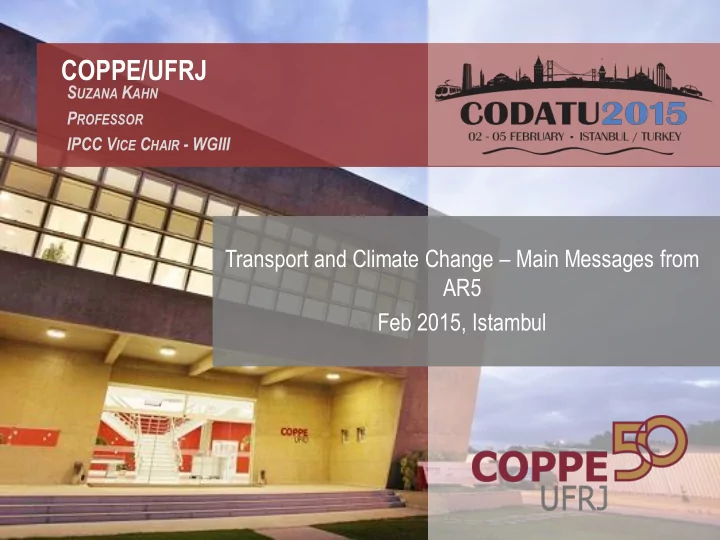

COPPE/UFRJ S UZANA K AHN P ROFESSOR IPCC V ICE C HAIR - WGIII Transport and Climate Change – Main Messages from AR5 Feb 2015, Istambul
Total Annual GHG Emissions by Groups of Gases 1970-2010
• GHG emissions growth - 49 GtCO 2eq /year in 2010 (highest in history) • CO2 main GHG; • 80% of emission increase is due to fossil fuel. Main Message – AR5
Share of direct emissions Share of direct and indirect emissions Allocation of GHG emission across economic sectors in 2010
TRANSPORT GHG EMISSIONS
Transport Sector produced 7.0 Gt CO 2-eq of direct emissions in 2010 ( responsible for approximately 23% of total energy-related CO2 emissions). Transport emissions could increase at a faster rate than emissions from any other energy end use sector and reach around 12 Gt CO 2-eq by 2050. FACTS AND ESTIMATIVES
• Activity – Total passenger-km/yr or freight tonne-km/yr having a positive feedback loop to the state of the economy but, in part, influenced by behavioural issues such as journey avoidance and restructuring freight logistics systems; • system infrastructure and modal choice ; • energy intensity – directly related to vehicle and engine design efficiency, driver behaviour during operation, and usage patterns; • fuel carbon intensity - varies for different transport fuels including electricity and hydrogen. GHG EMISSION DECOMPOSITION
Notes: p Km = Passenger-Km; t Km = tonne-Km; CNG = compressed naural gas; LPG = liquid petroleum gas. GHG EMISSION DECOMPOSITION
Transport ´ s share of total national GHG emissions range from up to 30% in high income economies to less than 3% in LDCs, mirroring the status of their industry and service sectors Petroleum product consumption to Drivers: Travel time budged; meet all transport (2009) Personal income increase; Costs and prices; Social and cultural factors. India and China; North 2 Gj/ capita America: each year 100 Gj/capita each year Newman and Kenworthy, 2001 TRANSPORT EMISSIONS DRIVERS
GHG emissions: • Non-OECD countries will contribute with 2/3 of total LDV ownership, that it is expected to double in the next few decades. Reaching 1 billion vehicles; • OECD countries will keep increasing air transport demand. Recent trends suggest that economic, lifestyle, and cultural changes will be insufficient to mitigate global increases in transport emissions without stringent policy instruments, incentives, or other interventions being needed. TRANSPORT EMISSIONS TRENDS
Technology Improvement and New Technology- related practice can make substantial contributions to climate change mitigation in transport sector • Design of new engines and vehicles ( fuel economy ) • New Fuels and Alternative energy sources • Telecomunication facilities TECHNOLOGICAL OPTIONS
• Avoiding journey where possible – by, for example, densifying urban landscapes, sourcing localized products, internet shopping, restructuring freight systems, and utilizing advanced information and communication technologies (ICT); • Modal shift to lower-carbon transport systems, - encouraged by increasing investment in public transport, walking and cycling infrastructure, and modifying roads, airports, ports and railways to become more attractive for users and minimize travel time and distance; • Lowering energy intensity (MJ/ passenger Km or MJ/tonne Km) – by enhancing vehicle and engine performance, using lightweight materials, increasing freight load factors and passenger occupancy rates, deploying new technologies such as electric three-wheelers; • Reducing carbon intensity of fuels (CO 2-eq /MJ) – by substituting oil-based products with natural gas, bio-methane, or biofuels, electricity or hydrogen produced from low GHG sources. In addition, indirect GHG emissions arise during the construction of infrastructure, manufacture of vehicles, and provision of fuels (well-to-tank). NON TECH OPTIONS TO REDUCE GHG IN TRANSPORT
GHG emissions per passenger-quilometre (p-Km) or per tonne-quilometre (t-Km) depend, inter alia , on the intensity of use of infrastructure and the share of tunnels, bridges, runways etc. Developments to improve infrastructure in rapidly urbanizing developing countries will decisively determine the future energy intensity of transport and concomitant emission, requiring policies and actions to avoid lock-in. Existing vehicle stock, road infrastructure and fuel-supply infrastructure prescribe future use and can lock-in emission paths for decades while inducing similar investment because of economies of scale. The life span of these infrastructure ranges from 50 to more than 100 years. Opportunities exist to substantially reduce these infrastructure related emissions, for instance by up to 40% in rail by the increased deployment of low-carbon materials and recycling of rail track materials at their end – of-life. INFRASTRUCTURE DEPENDENCY
Transport demand and land use are closely inter-linked . Urban population density inversely correlates with GHG emissions from land transport end enables non-motorised to be more viable. However, there exists a non-linear relationship between urban density and modal choice. URBAN FORM DEPENDENCY
Socio-economic, environmental and health effects • Energy security; • Access and mobility; • Employment impact; • Traffic congestion; • Health; • Safety; and, • Fossil fuel displacement. CO BENEFITS / RISKS / SPILLOVERS
Co-benefits ( green arrows ) and adverse side-effects ( orange arrows ) of the main mitigation measures in the transport sector. AR5 TRANSPORT SECTOR OVERVIEW ( CONT .)
Transport Tech & Practices with potential for both short- and long-term GHG reduction and the related barriers & opportunities AR5 TRANSPORT SECTOR OVERVIEW
CONT.
CONT.
CONT.
Possible pathways towards stabilization • Economic tools/co-benefits inclusion; • Innovation and deployment of low carbon tech; • Behavior change; • Role of Subsides. Final Remarks
• Without explicit efforts to reduce GHG emissions, the fundamental drivers of emissions growth are expected to persist • Infrastructure development that lock societies into GHG intensive emissions pathways may be difficult or very costly to change • Behavior lifestyle and culture have a considerable influence on energy use and its emission Final Remarks
Recommend
More recommend